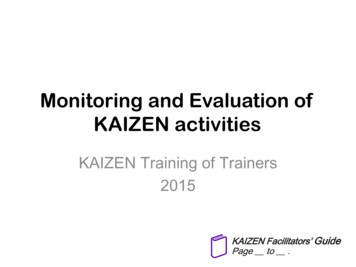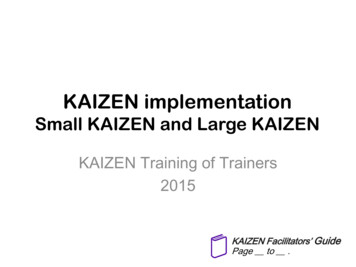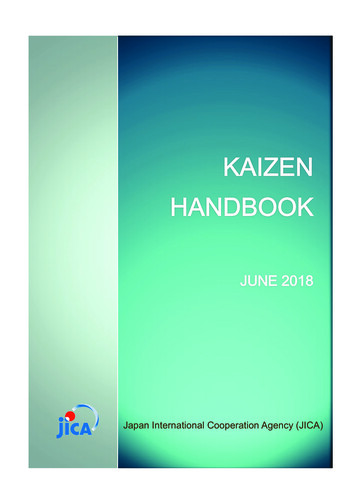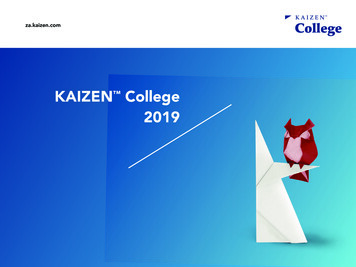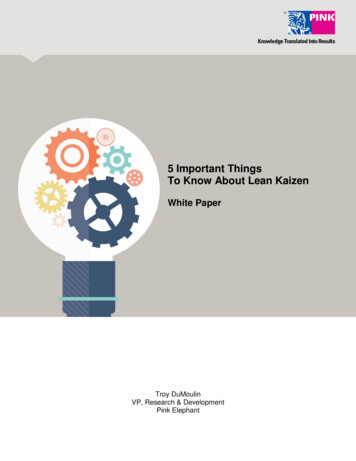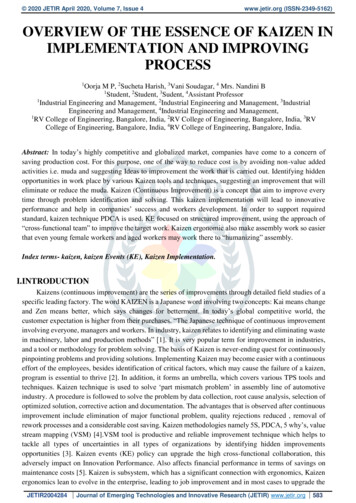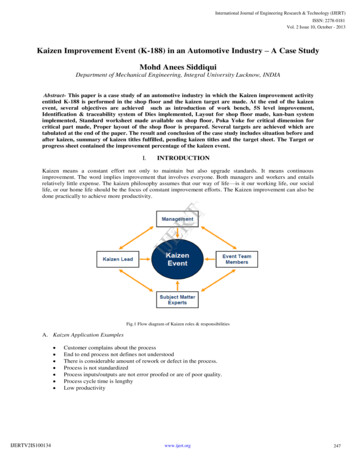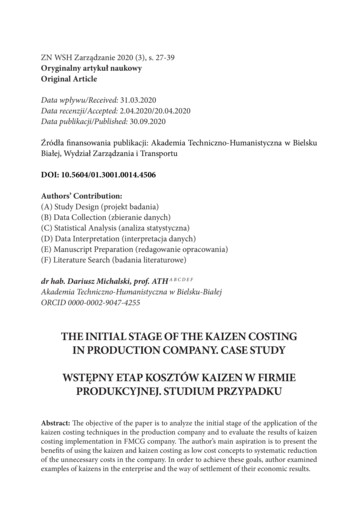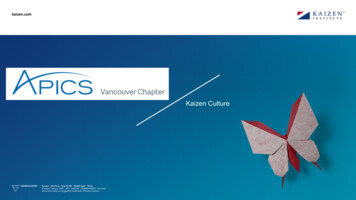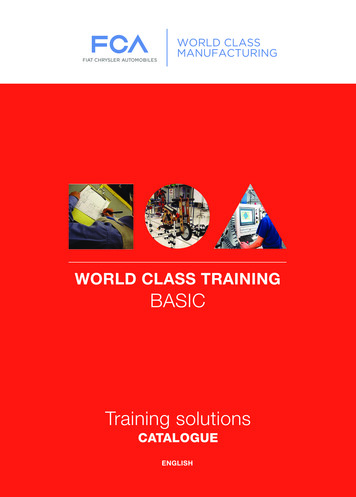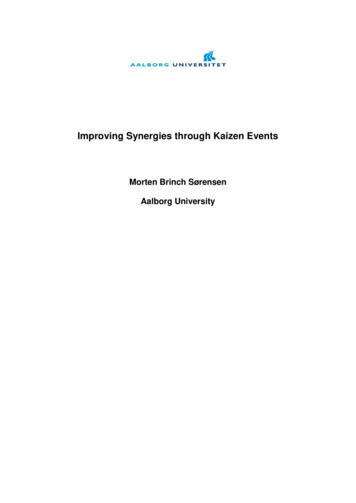
Transcription
Improving Synergies through Kaizen EventsMorten Brinch SørensenAalborg University
Improving Synergies through Kaizen EventsAalborg UniversityInternational Technology ManagementFibigerstræde 169220 Aalborg Øst, DKTel 45 99 40 71 17Fax 45 99 40 71 proving Synergies through Kaizen EventsSemester Theme:Final ThesisTheme of the project:Synergy and Kaizen EventsProject period:09.09.10 to31.05.11Author:Morten Brinch SørensenStudy Number:20090883University Advisors:Sami FarooqCooperating company:VIKING life-saving equipmentCooperating company advisor:Torben Hansen BredthauerPublications:5Number of pages:77Finished:31.05.11Side a
Improving Synergies through Kaizen EventsPrefaceThis report was made by Morten Brinch Sørensen studying M. Sc. in International TechnologyManagement 3rd and 4th semester at Aalborg University, Denmark. This report was developed incollaboration with VIKING life-saving equipment, Esbjerg, Denmark. First of all I would like tothank everyone from Viking who was involved in this project, for their time and cooperation.Secondly I would especially like to thank Torben Hansen Bredthauer, employee at Viking, forassisting with this project, and making it possible to get case study data from Viking.Furthermore I would like to thank Sami Farooq for being my university supervisor for this project.Morten Brinch SørensenSide b
Improving Synergies through Kaizen EventsAbstractThis report describes the development of a kaizen event synergy framework. The background forthe development was partly the task given by Viking life-saving equipment and partly the use ofsynergy in today’s business environment in order to get competitive advantage. The framework wasdeveloped on basis on a literature review. The framework introduces the concept of usingcontinuous improvement with kaizen events in order to focus synergy level improvements. Itfurthermore takes into consideration the needed continuous improvement support that is needed inorder to sustain continuous improvement and the kaizen events. The framework was used in a casestudy in order to estimate its usability and effect for an organization.The findings have shown that from the literature it was possible to construct a framework with ahigh potential of increasing synergy levels. The case study also showed that the constructedframework had a good potential for increasing synergies.Keywords:Continuous Improvement, Continuous Improvement Support, Kaizen, Kaizen Events, Kaizen EventSupport, SynergySide c
Improving Synergies through Kaizen EventsImproving Synergies through Kaizen Events . aPreface .bAbstract . cList of Figures . 3List of Tables . 4List of Abbreviations and Definitions . 5Chapter 1 Introduction . 61.1Introduction . 61.2Research Objectives . 71.3Research Questions . 71.4Scope of Research . 81.5Research Process . 8Chapter 2 Literature Review . 92.1Introduction . 92.2Continuous Improvement and Kaizen . 92.2.1 Passive Incremental. 102.2.2 Passive Breakthrough . 102.2.3 Enforced Incremental . 102.2.4 Enforced Breakthrough . 102.2.5 Blitz . 102.3 Kaizen Events . 112.3.1 Kaizen Events Groups . 112.4 Continuous Improvement and Kaizen Event Support . 152.5Organizational Synergy . 182.6Conclusion . 22Chapter 3 Research Methodology . 263.1Introduction . 263.2Research Methodology . 263.3Research Design . 273.4Reliability and Validity . 283.5Conclusion . 29Chapter 4 Kaizen Event Synergy Framework . 304.1Introduction . 304.2Kaizen Event Synergy Framework. 304.3Kaizen Event Plan . 314.4Kaizen Event Implement . 324.5Kaizen Event Sustain. 33Side 1
Improving Synergies through Kaizen Events4.6Synergy Level Assessment . 344.7Continuous Improvement Support . 364.8Conclusion . 38Chapter 5 Case Study . 395.1 Introduction . 395.2 The Interview . 395.3 The Survey . 405.4 Conclusion . 40Chapter 6 Case Study Analysis . 426.1 The Interview . 426.2 The Survey . 466.3 Conclusion . 47Chapter 7 Discussion and Conclusion . 497.1 Discussion . 497.2 Conclusion . 508 References . 529 Appendices . 54Appendix A . 54Appendix B . 60Appendix C . 66Appendix D . 69Appendix E . 72Appendix F. 77Side 2
Improving Synergies through Kaizen EventsList of FiguresFigure 1 - A classification of improvement types (Bicheno) . 9Figure 2 - The hierarchy of improvements (Bicheno) . 11Figure 3 - Kaizen event program framework (Van et al) . 14Figure 4 - Kaizen event research model (Farris et al) . 15Figure 5 - Continuous improvement model (Kaye et al) . 16Figure 6 - Value-enhanced collaborative working (Gohil) . 19Figure 7 - The synergy model (Bititci et al). 20Figure 8 - A classification of improvement types with choice (Bicheno) . 22Figure 9 - The hierarchy of improvements with choice (Bicheno) . 23Figure 10 - Kaizen event synergy framework . 25Figure 11 - Research design (Yin) . 27Figure 12 - Basic types of designs for case studies (Yin) . 28Figure 13 - Kaizen event synergy framework . 30Figure 14 - Kaizen event synergy framework - plan . 31Figure 15 - Kaizen event synergy framework - implement . 32Figure 16 - Kaizen event synergy framework - sustain . 33Figure 17 - Kaizen event synergy framework - synergy assessment . 34Figure 18 - Kaizen event synergy framework - CI support . 36Figure 19 - Kaizen event synergy framework . 38Figure 20 - Kaizen event synergy framework . 50Side 3
Improving Synergies through Kaizen EventsList of TablesTable 1 - Choice of research methodology (Yin) . 26Table 2 - Reliability and validity (Yin) . 29Table 3 - Interview and survey personal data . 40Table 4 - Framework Importance. 42Table 5 - Framework usability . 43Table 6 - Synergy improvements . 45Table 7 - Synergy improvements . 46Table 8 - Synergy assessment - survey overview . 46Table 9 - Synergy assessment - focus areas identified. 48Side 4
Improving Synergies through Kaizen EventsList of Abbreviations and DefinitionsViking life-saving equipment – VikingContinuous improvement - CISmall and medium sized enterprises - SME’sValue-enhanced collaborative working - VECWDefinition Continuous Improvement or Kaizen- Bicheno (Bicheno 2004) ―Kaizen is the Japanese word for continuous improvement and it iscentral to lean operations‖.Definition Kaizen Event- Van et al (Van et al. 2010) ―A kaizen event is ―a focused and structured improvementproject, using a dedicated cross-functional team to improve a targeted work area, withspecific goals, in an accelerated timeframe‖.Definition Synergy- Christensen (Becker-Christensen 2006) ―The effect or synergism synergy effect‖.Definition Synergism- Christensen (Becker-Christensen 2006) ―Interaction between two or more forces willprovide greater impact than just the sum of individual forces‖.Definition Collaboration- Bititci et al (Bititci and Turner and Mackay and Kearney and Parung and Walters 2007) ―Apositive form of working in association with others for some form of mutual benefit‖.Definition Assessment- Christensen (Becker-Christensen 2006) ―Consider something about value, quality or size ofsomething‖.Side 5
Improving Synergies through Kaizen EventsChapter 1Introduction1.1 IntroductionThe background for this project is based on a task given by Viking life-saving equipment (Viking).The task involved introducing and working with lean and continuous improvements (CI). Howeverat a very early point it was realized that implementing, driving and sustaining lean and CI wouldprove difficult within an organization were the departments seemed to work very separately with alow level of interactions between many of the departments.The best and most obvious example would be from the introduction sessions for new employees tothe different departments were the manager of marketing Elizabeth Pöckel made the followingstatement;―Technical Department! That’s the departments in the other building on the other side of the bighallway, but we never have anything to do with them in our daily work!‖The statement, however unintentional it probably was, showed to be more accurate than anticipated.The challenge was not only to work with lean and CI, which on an early stage can be more thandifficult with such a separated organization, but also to work with the area of making theorganization work better together and thereby making improved internal collaboration and/orsynergy.The literature within the field pointed towards the direction of using, the lean tool, kaizen events fordriving the CI against synergy improvements. Kaye (Kaye, Anderson 1999) highlights theimportance of using CI, by taking a qualitative point of view;―Approaches to quality have evolved significantly since the beginning of this century. Four majorquality eras have been identified; Inspection, statistical quality control, quality assurance andstrategic quality management. The strategic quality management approach however, is stillinadequate to meet today’s rapidly changing business environment characterized by uncertainty andunpredictability. To meet these challenges, a fifth quality era – competitive continuousimprovement – has been identified. For an organization to achieve flexibility, responsiveness andthe ability to adapt quickly to changes within its environment, the implementation of a soundstrategy for continuous improvement is essential‖.CI is indeed important in order to stay competitive in today’s business environment. Theimportance of kaizen events in relation to using CI is described by Van et al (Van et al. 2010);―With the increased use of lean work system practices in recent years, many organizations are usingkaizen events to rapidly introduce change and to create a culture of continual improvement‖.Side 6
Improving Synergies through Kaizen EventsKaizen events can potentially be used as a lean and CI tool to introduce changes, which potentiallycould include changes to the synergy area as well. The importance of synergy is stated by Bititci etal(Bititci and Turner and Mackay and Kearney and Parung and Walters 2007); ―In today’s globaleconomy, companies are trying to re-invent their businesses and maintain their competitiveadvantage through collaboration. Despite the fact that collaboration has significant benefits, earlierstudies also identified a high failure rate‖.Collaboration is essential in order to achieve synergy or synergistic effects and with a high failurerate, collaboration seems to be difficult to achieve. Cohen (Cohen, Bailey 1997) clarifies theimportance of group effectiveness which you can associate with kaizen events and goodcollaboration; ―The management and academic press increasingly emphasizes the importance ofteams for organizational success in the modern economy‖.Teams will affect general company tasks and processes, as long as kaizen events are using teamsefficiently, teams will have a strong impact on kaizen events long term. Another aspect which isimportant when using CI and kaizen events, in order to improve certain organizational areas, is thesupport function. The support function is important in order to both sustain the process itself butalso the changes made from the kaizen event process.The literature and Viking was leading the project theme in the direction of how you actively andeffectively can drive CI, through kaizen events, with the direction and focus of improving synergylevels. What is new to the existing literature is the approach of combining CI and Synergy todetermine if this will be an effective way of improving synergies.1.2 Research ObjectivesThe main research objectives can be described; To develop a usable framework that can increase synergy levels, within an organization,through a kaizen event, based on relevant literatureTo investigate and analyze the frameworks usability and effect through a case study atVikingTo demonstrate, evaluate and discuss the practical usability of the framework and synergyinfluence on organizations competitiveness.1.3 Research QuestionsThe main research questions relates to the objectives and explanation in the introduction; How can a framework increase synergy levels, within an organization, through a kaizenevent?How usable and effective will the framework be in an organization?How will the framework, by use of synergy, influence organizational competitiveness?Side 7
Improving Synergies through Kaizen Events1.4 Scope of ResearchThe scope of the research is to develop a framework that will help increase company synergy levelsand thereby increase the collaboration between divisions internal in an organization. Furthermore itis to review the literature to identify good practice, problems and gaps in relation. Lastly it is to testthe framework as a case study for the company Viking with analysis of the findings and evaluationsand discussions of the results.1.5 Research ProcessThe research process involved developing a kaizen event synergy framework by reviewing existingliterature within the fields of continuous improvement, synergy, kaizen events and continuousimprovement support. Furthermore other relevant areas were investigated in order to see if theywould have relevance for the framework being developed. The framework was used in a case studyat the company Viking, where interviews with experts were conducted in order to get an expertevaluation of the framework.Side 8
Improving Synergies through Kaizen EventsChapter 2Literature Review2.1IntroductionThe chapter will make a literature review of continuous improvement, kaizen event, Continuousimprovement support, and synergy. It will evaluate some of the shortcomings of the literature andfinally make a conclusion. The focus is based on the task given by Viking combined with thediscoveries made at the company, see chapter 1 for further explanation.2.2Continuous Improvement and KaizenBicheno (Bicheno 2004) defines kaizen as being the Japanese word for continuous improvementand it is central to lean operations. The word kaizen, originates from Maasaki Imai.According to Bicheno (Bicheno 2004) kaizen or CI can be classified in five different improvementtypes; passive incremental, passive breakthrough, enforced incremental, enforced breakthrough andblitz. See Figure 1.Incremental(Point Kaizen)Passive (Reactive)Enforced (Proactive)135 BlitzBreakthrough(Flow Kaizen)24Figure 1 - A classification of improvement types (Bicheno)Bicheno (Bicheno 2004) argues that passive incremental is passive or left to chance. It may also betermed ―reactive‖. A reaction takes place in response to a crisis. By contrast, enforcedimprovements are proactive. Crises can be engineered for the pressure to be kept on.Bicheno (Bicheno 2004) states that; ―There is, or should be, a place for all five types in everyorganization. Adopting lean manufacturing does not mean ignoring other forms of improvement toconcentrate on kaizen and blitz. Passive approaches are a useful supplement and should continue.However, if all improvements are of the passive, reactive type the company may well slip behind.Side 9
Improving Synergies through Kaizen Events2.2.1 Passive IncrementalPassive Incremental improvements can be the suggestion scheme with or without rewards, and withor without team emphasis. A team based passive incremental improvement example is the qualitycircle. According to Bicheno (Bicheno 2004) non-acknowledgement and non-recognition haveprobably been the major reason for suggestions schemes producing poor results and beingabandoned.2.2.2 Passive BreakthroughPassive Breakthroughs normally springs from traditional industrial engineering projects and workstudy projects, particularly if the initiative is left to the Industrial Engineering of work studydepartment Bicheno (Bicheno 2004). According to Bicheno (Bicheno 2004) passive breakthroughshave probably been the greatest source of productivity improvement over the past 100 years. It isdescribed by Bicheno (Bicheno 2004) as being the classic improvement method by industrialengineering and stated that it has been around for many years.2.2.3 Enforced IncrementalEnforced Incremental is driven waste elimination and thereby not only left to chance of operatorinitiative. Examples of drivers could be response analysis, line stop, inventory withdrawal, wastechecklist and the stage 1, stage 2 cycle. It is about setting up a culture that drives improvement,which constantly opens up new opportunities for another improvement activity Bicheno (Bicheno2004).2.2.4 Enforced BreakthroughEnforced Breakthroughs can be industrial engineering activities, for example initiated bymanagement or by crisis. It is driven by active value stream current and future state mapping whichgenerally target the complete value stream and followed up by action review cycles and an actionplan or master schedule Bicheno (Bicheno 2004).2.2.5 BlitzBlitz or kaizen events are a combination of Enforced Incremental and Enforced Breakthrough. It isbreakthrough because typical blitz events achieve between 25% and 70% improvements withineither a week or within a month at most. On the other hand it is incremental because blitz eventstypically relates to small areas so it is typically more point kaizen (local area) than flow kaizen (fullvalue stream). It is enforced because the expectations and opportunities are in place Bicheno(Bicheno 2004). According to Bicheno (Bicheno 2004) blitz events are not necessarily continuousimprovement if you see it as an isolated event. But blitz events should be repeated in the same areaat regular intervals. Product change, priority change, people change and technology improvement.Though the classifications are good to have in mind and usable in order to classify ones operations,the literature does not identify what is needed to achieve excellence in each area or in more areas atthe same time. Furthermore it does not state either if it is at all possible to master them all at thesame time.Side 10
Improving Synergies through Kaizen Events2.3Kaizen EventsMontabon’s (Montabon 2005) definition of a kaizen event; ―Kaizen events are essentially wellstructured, multi-day problem solving sessions involving a cross-functional team, who isempowered to use experimentation as they see fit to derive a solution(Montabon 2005)‖.Van et al’s (Van et al. 2010) definition of a kaizen event; ―A kaizen event is a focused andstructured improvement project, using a dedicated cross-functional team to improve a targeted workarea, with specific goals, in an accelerated timeframe‖. The two definitions are similar in manypoints and Van et al (Van et al. 2010) has been set for the standard definition for this report.First and foremost CI, lean and kaizen events are performed by organizations with groups andindividual people so it is important to categorize the different way of working in order to find thebest work approach according to improving synergy levels.2.3.1 Kaizen Events GroupsBicheno (Bicheno 2004) explains that the hierarchy of kaizen or lean improvements needs to beorganized into five levels. The organization needs to use most if not all levels in order to aspiretowards lean. Bicheno (Bicheno 2004) furthermore suggest to have a lean promotion office orsomething similar to promote lean and the changes and as a minimum use 1 to 2% of the workforcefull time during major implementations and hereafter 0,5 to 1%. Lastly he states that the existenceof a lean promotion office is an indication to the organizations commitment to lean.The Hierarchy of ImprovementsLevel 1: The IndivdualLevel 2: The Work Team or Mini Point KaizenLevel 3 Kaizen Blitz Group or Point KaizenLevel 4: Value Stream Improvements: Flow KaizenGroupsLevel 5: Supply Chain Kaizen GroupsFigure 2 - The hierarchy of improvements (Bicheno)Level 1: The IndividualLevel one, the individual, were individual employee’s needs to be recognized as being experts oftheir own process. They need to have the knowledge to understand their own processes in the bigpicture of organizational processes (wider value stream) and why their own process is important andnecessary. The ―know why‖ or underlying philosophy is the most important stage of learning andunderstanding. Hence Bicheno (Bicheno 2004) states that improvements and sustainability startswith the individual at the workplace.The team leaders are important as they can encourage, facilitate and recognize individualachievements. Furthermore they can bring individual improvements to the attention of others.Individual ―thank you‖ notes could be examples and carry much weight.Side 11
Improving Synergies through Kaizen EventsExamples of work; waste reduction, work piece orientation, inventory and tool location, worksequence, ergonomics and/or pokayoke.Level 2: The Work Team or Mini Point KaizenLevel two, the work team, consists of groups or teams, which work in a cell or on a line segment. Ifthey undertake an improvement workshop it will affect their collective work area. The initiativesmay be done regularly as a part of team meetings, but can also be conducted on 1-2 day workshop.Recognition is crucial, so the team needs to present it
effectively can drive CI, through kaizen events, with the direction and focus of improving synergy levels. What is new to the existing literature is the approach of combining CI and Synergy to determine if this will be an effective way of improving synergies. 1.2 Research Objectives The main research objectives can be described;
